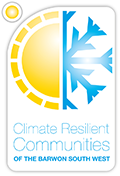Revegetation
Revegetation is another recognised method of encouraging carbon sequestration through the Australian Government’s ERF. Revegetation, through biodiverse plantings, has many other NRM benefits, and is one of the most effective ways to make many of the region’s landscapes more resilient to climate change. Mainly through buffering existing remnants, protecting riparian areas and reducing existing threatening processes such as soil erosion.
Revegetation can also increase connectivity i.e. buffers, corridors, stepping stones, between existing areas of fauna habitat, and create refugia. This will be important as the region’s climate changes and some fauna in existing locations need to move to more favourable areas.
Species selection for revegetation programs will reflect what is currently being planted now, i.e. species indigenous to the area. With projected changes to the region’s climate, there is an expectation existing plant species will need to be replaced with species that are more suitable to a warmer, drier climate. Feedback from regional experts through the development of the NRM Planning for Climate Change Plans discussed this potential need, however, it was determined that EVCs are quite resilient in their own right, and while some may lose certain species, there is no requirement to replace indigenous species with those that may be deemed more appropriate under a changing climate.
Revegetation priorities for carbon sequestration purposes should be assessed on a site-by-site basis, with other NRM benefits being used to help prioritise potential sites. Figure One below displays the green carbon sequestration priority areas within the Corangamite CMA region. Areas highlighted light green are areas of high carbon carbon sequestration potential, combined with other NRM benefits such as buffering and linking remnant vegetation, and should be used as a guide only.
Figure 1. Green Carbon Sequestration Areas - Corangamite Region
For an overview of green sequestration priorty areas within the Glenelg-Hopkins region, please visit https://www.swclimatechange.com.au/cb_pages/regional_planning.php








